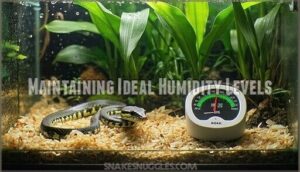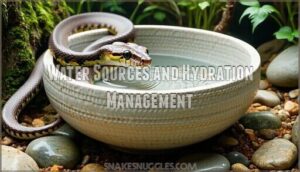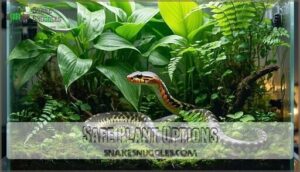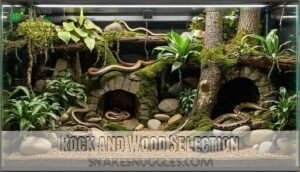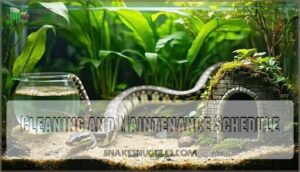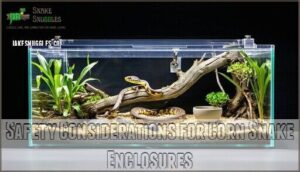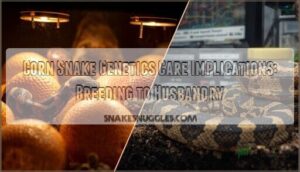This site is supported by our readers. We may earn a commission, at no cost to you, if you purchase through links.
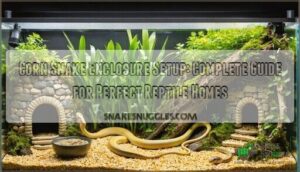 Your corn snake enclosure setup starts with a 40-gallon long tank minimum, though bigger gives your snake more room to roam.
Your corn snake enclosure setup starts with a 40-gallon long tank minimum, though bigger gives your snake more room to roam.
Create a temperature gradient from 85-88°F on the warm side to 75-80°F on the cool side using under-tank heaters.
Maintain 40-60% humidity with a water bowl and occasional misting. Choose aspen shavings or cypress mulch for substrate that allows natural burrowing.
Provide hiding spots on both temperature zones, plus climbing branches for exercise. Secure ventilation prevents escapes while maintaining airflow.
The right foundation makes all the difference, but getting the details perfect requires knowing which mistakes can turn your snake’s dream home into a nightmare.
Table Of Contents
- Key Takeaways
- Choosing The Right Tank for Corn Snakes
- Optimal Substrate Options for Corn Snake Habitats
- Creating a Proper Temperature Gradient
- Lighting Requirements for Corn Snake Enclosures
- Maintaining Ideal Humidity Levels
- Essential Hiding Spots and Enrichment Items
- Water Sources and Hydration Management
- Decorating The Enclosure: Natural Vs. Artificial
- Cleaning and Maintenance Schedule
- Safety Considerations for Corn Snake Enclosures
- Frequently Asked Questions (FAQs)
- What does a corn snake need in its enclosure?
- Do corn snakes like heat mats or lamps?
- What is the best tank setup for a corn snake?
- How to set up a cage for a corn snake?
- How do you set up a corn snake enclosure?
- Do corn snakes need a large enclosure?
- Do corn snakes need a bioactive enclosure?
- What equipment do I need for a corn snake enclosure?
- How to make a corn snake enclosure more attractive?
- How do you heat a corn snake enclosure?
- Conclusion
Key Takeaways
- You’ll need a minimum 40-gallon long tank with secure mesh lid and proper ventilation to prevent escapes while maintaining healthy airflow for your corn snake.
- Create a temperature gradient from 85-88°F on the warm side to 75-80°F on the cool side using overhead heat lamps, and maintain 40-60% humidity with a water bowl and occasional misting.
- Provide 3-4 inches of substrate like aspen shavings or cypress mulch for natural burrowing behavior, plus hiding spots on both temperature zones and climbing branches for exercise.
- Establish a consistent cleaning routine with immediate waste removal and deep cleaning every 4-6 weeks using reptile-safe disinfectants to prevent harmful bacteria buildup.
Choosing The Right Tank for Corn Snakes
Selecting the right tank for your corn snake determines whether your pet thrives or simply survives in captivity.
You’ll need to examine tank size, material type, and ventilation requirements to create a habitat that supports your snake’s natural behaviors and long-term health.
Tank Size Requirements
When setting up your corn snake’s home, size matters more than you might think.
Your snake’s comfort depends on having enough space to stretch, explore, and feel secure.
Your corn snake deserves room to roam—cramped quarters create stressed serpents, while spacious homes breed happy, healthy reptiles.
Start with these minimum requirements based on your snake’s age:
- Hatchling Tank: 10-20 gallon long enclosure for babies
- Juvenile Space: 30-40 gallon tank as they grow
- Adult Dimensions: 48"x24"x24" minimum for full-grown snakes
Focus on horizontal space over vertical space since corn snakes prefer ground-level movement.
A 40-gallon tank works for single adults, but larger enclosures reduce stress substantially.
Consider appropriate habitat products to enhance your snake’s environment.
The extra room allows for proper temperature gradients and enrichment impact.
Remember, you can’t go too big with snake enclosure size—your corn snake will appreciate the additional space for natural behaviors and exercise.
Glass Vs. Plastic Enclosures
Once you’ve determined your enclosure size, choosing between glass and plastic becomes your next vital decision.
Each enclosure type offers distinct advantages for your corn snake’s home:
- Heat Retention – Plastic enclosures maintain temperatures more efficiently than glass tanks
- Humidity Control – Plastic materials naturally preserve moisture levels better
- Weight Comparison – Glass tanks become substantially heavier, especially larger sizes
Glass tanks provide crystal-clear visibility for observing your snake’s behavior. Many keepers consider glass tank options for their clarity.
However, plastic enclosures excel in cost analysis and durability factors, making them practical choices for many keepers.
Ventilation Considerations
Whether you’ve chosen glass or plastic, proper ventilation makes the difference between a thriving snake and a sick one. Think of your corn snake’s enclosure like your home—you wouldn’t want to live in a stuffy, humid box either.
Airflow Importance can’t be overstated. Poor ventilation creates a breeding ground for harmful bacteria and respiratory problems. A metal screen lid provides the perfect solution, allowing fresh air to circulate while keeping your snake secure inside.
Here’s what proper snake enclosure ventilation accomplishes:
- Mold Prevention through consistent air circulation
- Humidity Control without creating stagnant pockets
- Temperature regulation across thermal zones
- Excess humidity removal that prevents bacterial growth
Mesh Top Benefits include easy lamp installation and ideal Vent Placement for natural airflow patterns. For the best setup, consider specialized enclosure products. Larger enclosures naturally provide better ventilation, giving your snake the fresh environment it deserves.
Optimal Substrate Options for Corn Snake Habitats
Your snake’s foundation matters more than you’d think. The right corn snake substrate creates a comfortable home that supports natural behaviors.
Aspen vs. Fiber debates often confuse new owners, but each serves different needs.
| Substrate Type | Best For |
|---|---|
| Aspen Shavings | Dry climates, easy cleaning |
| Coconut Fiber | Humidity retention, naturalistic look |
| Organic Topsoil | Substrate Layering with leaf litter |
Burrowing Depth should reach 3-4 inches minimum. This allows proper tunneling while preventing Mold Prevention issues.
Soil Composition affects humidity levels substantially. Paper towels work temporarily, but naturalistic reptile substrate options better replicate wild conditions.
Your snake enclosure substrate choice impacts shedding, comfort, and overall health.
Creating a Proper Temperature Gradient
You’ll need to establish a temperature gradient that ranges from 85-90°F on the warm side to 75-80°F on the cool side, allowing your corn snake to regulate its body temperature naturally.
This thermal range mimics their natural habitat and guarantees proper digestion, metabolism, and overall health throughout the enclosure, which is crucial for the snake’s overall health.
Basking Area Setup
Creating the perfect basking area requires strategic heat lamp placement and careful temperature monitoring.
Position your basking lamps 12-18 inches above a flat surface, maintaining safe basking distance to prevent burns.
Thermostat placement near the basking spot guarantees consistent 90°F temperatures.
Smart basking bulb choice—ceramic or halogen—paired with proper gradient importance gives your corn snake the thermal control it craves for maximum health.
Cold Side Temperature Management
Temperature control on the cool side creates your snake’s essential retreat zone. The cold end of your enclosure should maintain steady temperatures between 75-82°F, giving your corn snake the perfect spot to regulate its body heat naturally.
Proper cool side management guarantees your pet can escape excessive warmth when needed.
Here’s how to nail the temperature gradient:
- Place your thermometer at the furthest point from heat sources for accurate cool side readings
- Allow nighttime drops to 70°F to mimic natural temperature cycles
- Position insulation methods like cork bark or plants to maintain stable cool zones
- Choose the cool side location away from windows or drafts that cause temperature fluctuations
- Monitor species variation as some corn snakes prefer slightly different cool temperatures
Heating Equipment Selection
Choosing the right heating equipment transforms your corn snake’s enclosure from basic to brilliant. Your snake depends on proper temperature control for digestion, activity, and overall health.
Heat lamps serve as your primary heating source, with halogen flood bulbs providing the most effective infrared output that mimics natural sunlight. Position these overhead at one end of the enclosure to create that essential temperature gradient your snake craves.
For nighttime warmth without disrupting sleep cycles, ceramic heat emitters work perfectly. These devices provide consistent heat without light emission, maintaining comfortable temperatures around the clock.
Consider these essential heating components:
- Thermostat placement near the basking zone for accurate temperature regulation
- Basking lamp wattage matched to your enclosure size and ambient room temperature
- Heat mat safety protocols limiting coverage to one-third of the tank floor
Avoid relying solely on undertank heaters as your primary heat source. While infrared bulbs and ceramic heat emitters excel at creating proper thermal gradients, heat mats work best as supplementary heating only.
Lighting Requirements for Corn Snake Enclosures
You’ll need to provide 10-12 hours of light daily to mimic your corn snake’s natural day and night cycle.
This lighting schedule helps regulate their behavior and maintains their health, though corn snakes don’t require special UVB lighting like many other reptiles.
Day/Night Cycle Simulation
Your corn snake’s internal clock depends on consistent lighting cycles that mirror nature’s rhythm.
A light timer automatically manages this schedule, providing 10-12 hours of daylight followed by complete darkness.
This daynight cycle supports healthy sleep patterns and circadian rhythm regulation.
Seasonal variation isn’t necessary for corn snakes, but consistent lighting cycle prevents stress and promotes natural behavioral changes that keep your snake healthy and active.
UVB Lighting Considerations
Despite corn snakes thriving without UVB lighting, adding it can substantially boost your snake’s overall health and natural behaviors.
UVB benefits include enhanced vitamin D3 synthesis, improved coloration, and better circadian rhythm regulation in your corn snake habitat.
Here are the essential UVB lighting requirements for your snake enclosure setup:
- Use T5 HO fluorescent tubes from trusted brands like Arcadia or ZooMed
- Maintain UVI levels between 2.0-3.0 in the basking area
- Replace bulbs every 6-12 months to guarantee the best spectrum requirements
- Install mesh guards to prevent direct contact with your snake
- Provide shaded areas so your reptile can control exposure
Lamp placement matters tremendously for snake health.
Position your UVB fixture next to heat lamps, covering one-third to half your enclosure’s length.
Remember that UVB can’t penetrate glass or plastic, so proper reptile lighting setup requires unobstructed access.
Duration control involves providing 10-12 hours of UVB exposure daily.
Maintaining Ideal Humidity Levels
You’ll need to maintain humidity levels between 40-60% to keep your corn snake healthy and support proper shedding.
Monitor these levels with a digital hygrometer, and adjust moisture through water bowl placement and occasional misting when needed.
Humidity Range for Corn Snakes
Proper lighting sets the stage, but humidity levels make or break your corn snake habitat success.
You’ll need to maintain humidity between 40-70%, with the sweet spot hitting 65-75% for peak health.
| Humidity Range | Impact | Monitoring |
|---|---|---|
| 40-50% | Normal | Digital Hygrometer |
| 50-60% | Good | Weekly Check |
| 65-75% | Ideal | Daily Observation |
| 75-80% | Shedding Support | Consistent Tracking |
| 80%+ | Risk Zone | Immediate Adjustment |
An ideal hygrometer becomes your monitoring lifeline.
Low humidity creates shedding problems and hydration effects that stress your snake.
High levels invite respiratory issues and bacterial growth.
Seasonal variation affects these readings, so check daily during winter heating and summer air conditioning periods.
Consistent corn snake humidity prevents health complications.
Misting and Water Bowl Placement
Water management creates the foundation for your corn snake’s health.
Strategic placement and proper misting techniques maintain ideal humidity levels throughout the enclosure.
- Position your snake water dish between temperature zones to maximize bowl evaporation and create a natural humidity gradient
- Mist one side of the enclosure every 2-3 days to establish proper misting frequency without oversaturating
- Use dechlorinated water quality for both the water bowl and misting to guarantee safe snake hydration
Hygrometer Usage
After establishing your misting routine and water bowl placement, you’ll need accurate readings to track your snake enclosure humidity effectively. Your hygrometer becomes your best friend for monitoring humidity levels throughout the day.
Smart hygrometer placement makes all the difference in getting reliable readings. The key considerations include:
- Position sensors at mid-height, away from water bowls and misting zones
- Use multiple units to monitor different areas of the enclosure
- Place one near the warm side and another on the cool side
- Keep digital models away from direct heat sources to prevent false readings
Digital vs analog hygrometers each have their strengths. Digital units offer precise accuracy range within 2-3%, while analog versions provide reliable backup readings. Calibration methods vary by model, but most digital hygrometers need monthly checks using salt test methods.
Check your monitoring frequency twice daily during setup, then weekly once humidity control stabilizes. This consistent approach guarantees your corn snake stays comfortable year-round.
Essential Hiding Spots and Enrichment Items
You’ll need to create multiple hiding spots and enrichment features that mimic your corn snake’s natural habitat and support its behavioral needs.
Proper hides on both warm and cool sides, along with climbing branches and burrowing substrate, reduce stress and encourage natural behaviors like thermoregulation and exploration.
Natural Vs. Artificial Hides
With proper humidity levels established, you’ll need secure hiding spots that match your corn snake’s natural instincts.
Your reptile hide selection directly impacts your pet’s stress levels and overall well-being.
Natural hides like cork bark and driftwood create an authentic snake enclosure setup that mimics their wild environment.
These materials offer texture and scent variation that appeals to corn snakes.
However, artificial hides provide consistent sizing and easier maintenance routines.
| Natural Hides | Artificial Hides |
|---|---|
| Cork bark, driftwood, hollow logs | Plastic caves, resin formations |
| Authentic textures and scents | Easy cleaning and disinfection |
| Variable sizes, weathering over time | Consistent dimensions, long-lasting |
Your corn snake habitat needs multiple hiding spots—place one hide on each temperature zone.
Choose appropriately sized options where your snake feels snug but not cramped.
Climbing Structures and Branches
Enrichment Value skyrockets when you add climbing structures to your corn snake’s world. These reptiles love exploring vertical spaces, making Branch Placement vital for their wellbeing.
Here’s your climbing setup checklist:
- Select Wood Types like manzanita or oak that won’t splinter
- Verify branches are thicker than your snake’s widest point
- Create Secure Mounting using aquarium-safe silicone or clips
- Position climbing structures at various angles for interest
- Maintain Climbing Safety by avoiding sharp edges or weak joints
Your snake enclosure decor transforms from basic to brilliant with thoughtful climbing additions. These branches provide exercise opportunities while showcasing your corn snake’s natural behaviors.
Substrate Burrowing Areas
While your corn snake enjoys climbing adventures, they’ll spend equal time exploring below ground. Creating proper burrowing areas satisfies their natural digging instincts and provides security.
Substrate depth of 3-4 inches allows comfortable tunneling, while substrate types like coconut fiber and aspen shavings offer ideal texture.
Here’s your substrate layering blueprint:
- Base layer of coconut fiber for moisture retention
- Middle layer of aspen shavings for structure
- Top layer of organic topsoil for natural feel
- Leaf litter sprinkled across surface for exploration.
This substrate quantity supports healthy burrowing behavior and provides a natural environment with proper burrowing conditions.
Water Sources and Hydration Management
You’ll need to provide fresh water consistently to keep your corn snake healthy and support proper shedding.
Water management involves choosing the right bowl size and maintaining clean water through regular changes.
Water Bowl Size and Placement
Your corn snake’s water dish serves as both drinking fountain and humidity control center. Choose a heavy ceramic bowl material that won’t budge when your snake investigates—lightweight plastic dishes create chaos and stress.
Size the water bowl to match your snake size: juveniles need smaller dishes, while adults require bowls they can partially coil inside. Water depth should reach 2-3 inches—enough for drinking without drowning risks.
Position the dish on the cool side to prevent rapid evaporation and maintain stable humidity levels. This placement naturally supports humidity maintenance throughout the enclosure.
Heavy ceramic or thick glass prevents spillage prevention issues that plague lighter materials. Your water dish becomes a reliable humidity source while serving your snake’s hydration needs. Proper sizing and placement create the foundation for healthy humidity without constant adjustments.
Regular Cleaning and Refilling
Once you’ve positioned your water bowl perfectly, maintaining it becomes your snake’s lifeline. Think of yourself as a water quality manager—your corn snake’s health depends on your cleaning routine.
Here’s your maintenance blueprint:
- Daily Water Changes – Replace water every 24 hours to prevent bacterial buildup and maintain freshness
- Weekly Dish Sanitization – Deep cleaning with reptile-friendly disinfectant removes stubborn residue and odors
- Spot Cleaning Protocol – Remove floating debris immediately and check for substrate contamination during changes
Use a dedicated cleaning cloth for Waste Removal and always dry the bowl completely before refilling. Schedule Adherence keeps your snake healthy—consistency matters more than perfection.
When Substrate Replacement occurs during deep cleaning sessions, inspect the water area for hidden contaminants that could compromise your snake’s hydration.
Decorating The Enclosure: Natural Vs. Artificial
You’ll need to choose between natural decorations like real wood and rocks versus artificial alternatives that offer easier maintenance and safety.
Both options can create an attractive habitat, but each comes with specific benefits and considerations for your corn snake’s health and comfort.
Safe Plant Options
Now that your snake’s hydration needs are sorted, adding greenery transforms your reptile enclosure into a living masterpiece.
Your snake enclosure benefits from nontoxic plants like pothos, spider plants, and ferns. These edible plants pose minimal toxicity levels when properly prepared.
| Plant Type | Maintenance Needs |
|---|---|
| Pothos | Weekly watering |
| Spider Plants | Bi-weekly care |
| Ferns | Daily misting |
| Bromeliads | Monthly feeding |
Smart plant placement near water dishes supports humidity while ensuring root safety doesn’t compromise your reptile habitat’s functionality.
Rock and Wood Selection
Most reptile keepers underestimate how vital proper rock and wood selection becomes for snake tank setup.
You’ll need to evaluate rock porosity and wood toxicity before adding anything to your reptile enclosure setup. Safe sourcing means avoiding chemically treated materials that could harm your snake.
| Material | Weight Rating | Toxicity Risk |
|---|---|---|
| Cork Bark | Light | None |
| Sandstone | Heavy | Low |
| Cedar Wood | Medium | High |
Consider weight considerations and climbing angles when positioning branches. Sanitize all décor thoroughly before installation to create the perfect reptile habitat setup with a focus on safe sourcing.
Cleaning and Maintenance Schedule
A clean enclosure keeps your corn snake healthy and prevents harmful bacteria from building up in the habitat.
You’ll need to remove waste immediately when you spot it, and perform thorough cleaning every 4-6 weeks to maintain proper hygiene standards and keep your snake healthy.
Spot Cleaning Techniques
Daily maintenance keeps your corn snake’s home spotless and healthy.
Spot cleaning becomes second nature when you follow these essential steps:
- Feces Removal and Urates Disposal using a reptile-safe scoop within minutes of discovery
- Substrate Sifting around the waste area to eliminate contaminated bedding completely
- Spill Cleanup from water bowls or feeding accidents using paper towels immediately
- Mold Prevention by checking humid areas and corners for early moisture buildup
This targeted reptile cleaning approach prevents bacteria growth while maintaining your snake’s fresh, hygienic environment between thorough cleanings.
Deep Cleaning Frequency
Every two months marks the perfect rhythm for thorough snake enclosure cleaning.
This deep cleaning session involves complete substrate replacement, thorough scrubbing of all habitat components, and precise sterilization to prevent waste buildup and bacteria growth.
Regular deep cleaning schedules combat mold prevention challenges while supporting your snake’s shedding impact needs.
Consistent maintenance creates healthier living conditions for ideal reptile care, which is essential for ideal reptile care.
Disinfection Methods
Proper sterilization keeps your corn snake healthy and prevents disease outbreaks. Bleach solutions at 10% concentration effectively kill harmful bacteria, while safe disinfectants like chlorhexidine offer gentler alternatives.
Always make certain of complete residue removal through thorough rinsing after applying any reptile-safe cleaners.
- Apply disinfectant generously and let sit 10-15 minutes
- Rinse thoroughly with fresh water after sterilization
- Use separate solutions for quarantine procedures
- Replace substrate only when enclosure is completely dry
Safety Considerations for Corn Snake Enclosures
Keeping your corn snake safe starts with an escape-proof enclosure and avoiding harmful materials.
A secure lid, proper ventilation, and non-toxic decor are essential to prevent injuries and guarantee a stress-free environment.
Escape-Proofing Measures
Master craftsmen know that even tiny gaps spell trouble when housing escape artists like corn snakes. Your snake’s incredible flexibility means quarter-inch openings become highways to freedom.
Follow these essential snake enclosure escapeproofing steps:
- Lid Security – Install locking mechanisms on all access points, ensuring no lifting or sliding without deliberate action
- Hiding Gaps – Seal ventilation areas with appropriately-sized mesh that prevents squeezing through while maintaining airflow
- Cord Management – Route heating cables through secure grommets, eliminating spaces where snakes might push through
- Hatchling Security – Use extra-fine screening for young snakes who slip through standard mesh
Reinforcement methods include overlapping latches and weighted tops.
Remember: your snake’s determination exceeds your initial expectations every time.
Avoiding Harmful Materials
Beyond escape-proofing, you’ll need to watch for materials that can harm your snake. Toxic woods like cedar and pine release harmful oils that damage respiratory systems.
Unsafe plastics containing phthalates pose serious health risks through chemical exposure. Avoid decorations with lead risks – painted items, glazed ceramics, and cheap metal accessories often contain this dangerous element.
Sharp edges on rocks, glass, or broken items can injure your snake during movement. Choose reptile-safe materials exclusively: sealed hardwoods, food-grade plastics, and certified reptile-friendly decorations.
When cleaning your snake enclosure, use reptile-approved products only. Your reptile enclosure should contain nothing questionable.
Proper Lid Security
Corn snakes can squeeze through gaps you wouldn’t think possible, making secure lid systems your first line of defense.
Choose heavy-duty lid materials like reinforced mesh or solid panels with reliable locking mechanisms that won’t fail under pressure.
Weight considerations matter – lightweight lids invite trouble, while proper hinge durability prevents warping over time.
Consider these snake enclosure security essentials:
- Childproofing options like cabinet locks add extra protection
- Multiple locking points distribute pressure evenly across the secure lid
- Regular inspection prevents locking lid failures before they happen
- Backup latches provide redundancy when primary locks wear out
Your snake enclosure lid security directly impacts your peace of mind.
Frequently Asked Questions (FAQs)
What does a corn snake need in its enclosure?
Want your slithery friend to thrive? You’ll need a 40+ gallon tank with proper heating (85-90°F warm side), humidity at 40-60%, hiding spots, climbing branches, water dish, and burrowing substrate.
Do corn snakes like heat mats or lamps?
Both heat sources work well for corn snakes, but many keepers prefer heat lamps because they create natural basking spots and temperature gradients.
Heat mats provide belly heat but don’t warm the air effectively.
What is the best tank setup for a corn snake?
You’ll need a 40+ gallon tank with secure ventilation, temperature gradient from 75-90°F using heat lamps, 40-60% humidity, 3-4 inches of substrate for burrowing, hiding spots, and climbing branches.
How to set up a cage for a corn snake?
Setting up your corn snake’s perfect home isn’t rocket science.
You’ll need a 40-gallon tank with heating, substrate for burrowing, hiding spots, water dish, and proper ventilation to create their ideal sanctuary.
This setup will provide your corn snake with the necessary environment for a healthy life.
How do you set up a corn snake enclosure?
Choose a 40+ gallon tank with secure mesh lid.
Add 3-4 inches of substrate for burrowing.
Create temperature gradient with basking spot at 90°F and cool side at 75°F.
Include hiding spots and water dish.
Do corn snakes need a large enclosure?
Yes, corn snakes require spacious enclosures.
Adults need minimum 40-gallon tanks, preferably 48"x24"x24" or larger.
This space allows proper temperature gradients, climbing opportunities, and natural behaviors that keep your snake healthy and stress-free.
Do corn snakes need a bioactive enclosure?
Think of bioactive setups as nature’s cleaning crew – they’re helpful but not essential.
You don’t need a bioactive enclosure for your corn snake’s health, though it can reduce maintenance and create a more natural environment.
What equipment do I need for a corn snake enclosure?
You’ll need a 40+ gallon tank, heating equipment with thermostat, substrate for burrowing, hiding spots, water dish, thermometer, hygrometer, and secure mesh lid.
Don’t forget climbing branches and proper lighting for your snake’s comfort.
How to make a corn snake enclosure more attractive?
Add live plants like pothos or snake plants, include natural branches for climbing, use varied substrate textures.
Create multiple hiding spots with different materials, and incorporate realistic rock formations to mimic their wild habitat beautifully, including natural elements.
How do you heat a corn snake enclosure?
Don’t worry about complicated setups – heating your corn snake enclosure is straightforward.
Use heat lamps or under-tank heaters with thermostats to create an 85-90°F warm side and 75-80°F cool side temperature gradient.
Conclusion
Perfect corn snake enclosure setup transforms your pet’s quality of life dramatically.
Studies show snakes in properly configured habitats live 30% longer than those in basic setups.
You’ve learned the essential elements: appropriate tank size, temperature gradients, humidity control, and enrichment features.
Remember that your snake’s enclosure isn’t just housing—it’s their entire world.
Take time to implement each component correctly, monitor conditions regularly, and adjust as needed to ensure your corn snake will thrive in their carefully crafted home.
- https://reptilesupply.com/blogs/how-to-guides/how-to-set-up-a-corn-snake-enclosure
- https://www.rspca.org.uk/documents/1494939/0/Corn+Snake+Care+Sheet+%28PDF+363KB%29.pdf/eab3d86d-0531-0625-5056-ca75887626a8?t=1556101010993
- https://www.quora.com/What-is-the-best-setup-for-a-corn-snake-over-the-different-stages-of-life
- https://exoticdirect.co.uk/news/corn-snake-set-up-advice/
- https://dubiaroaches.com/blogs/how-to-guides/how-to-set-up-a-corn-snake-terrarium?srsltid=AfmBOoquUNds4ELXdpAZMeLGeQAjy2Oe4mUwvWCTC_YTXcOtbcC_YtSO



